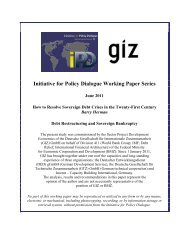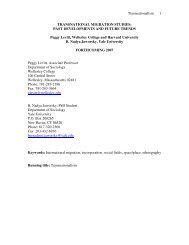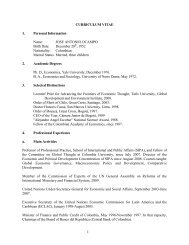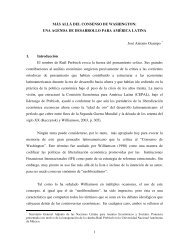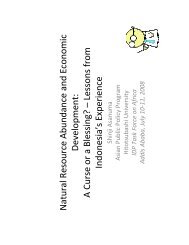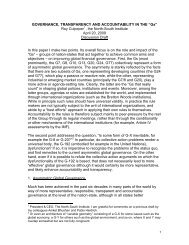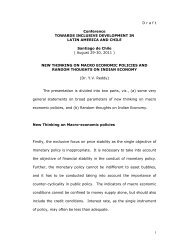Paper - Initiative for Policy Dialogue
Paper - Initiative for Policy Dialogue
Paper - Initiative for Policy Dialogue
Create successful ePaper yourself
Turn your PDF publications into a flip-book with our unique Google optimized e-Paper software.
26<br />
measures to encourage a supply response through a package of support, including access<br />
to term credit at reasonable interest rates, infrastructure, and the establishment of a<br />
leather institute to promote acquisition of technological capability and skills. The<br />
government was now seeking to rein<strong>for</strong>ce early successes by promoting further value<br />
addition by moving up the chain from processed leather to footwear exports. Similar<br />
comprehensive packages of support had spurred rapid growth in the non-traditional<br />
exports of flowers. As a result of industrial policies, the share of “high-technology<br />
exports” in manufactured exports, though still tiny, had gone up from zero to 3 percent<br />
between 2000 and 2007 45 . Kenya too has had successful industrial policies, both in<br />
horticulture and tea. 46<br />
Other African examples of LIT policies are discussed in other chapters of this<br />
volume. The South African governments ef<strong>for</strong>ts’ at LIT policies are the subject of<br />
Nimrod Zalk’s paper in this volume; (whilst a note in Appendix xx discusses the ef<strong>for</strong>ts<br />
of a private firm, South African breweries --sometimes working with the government-- to<br />
adapt to and encourage production of local raw materials in countries it had invested in).<br />
Sen and Te Velde discuss state-business relations, an important aspect of East Asia’s<br />
successful industrial policies, in several African countries. (There is a simple rationale<br />
<strong>for</strong> this coordination: with market imperfections, prices do an imperfect job at “market<br />
coordination.” 47 Other contributions in this volume that emphasize consultative<br />
mechanisms <strong>for</strong> exchange of in<strong>for</strong>mation and coordination between the sate and the<br />
private sector include the contributions of Oyeyinke and Sampath, Bailey, Lenihan and<br />
Singh, Ohno and Ohno, and Hanatani and Watanabe).<br />
What lessons can be learnt from these experiences in Africa and East Asia Under<br />
what circumstances or <strong>for</strong> what types of states, should what sort of LIT policies be put on<br />
the menu of policy options What sort of “health warning” should they carry How can<br />
one reduce the risks of picking losers rather than winners Is it better to focus on broad<br />
based policies—promoting all exports through exchange rate policies—rather than<br />
particular sectors, let alone particular firms Several aspects of Africa’s distinctive<br />
situation, noted earlier, give particular salience to these issues. Is it possible, <strong>for</strong> instance,<br />
<strong>for</strong> Africa to reverse de-industrialization and increase employment opportunities in the<br />
industrial or <strong>for</strong>mal sectors without some <strong>for</strong>m of LIT policy Indeed, can Africa narrow<br />
the agricultural productivity gap with the other regions without a LIT policy <strong>for</strong><br />
44 It was noted that restrictions on exports of raw materials can be used to offset the disincentive effect on<br />
processing in developing countries on account of tariff escalation in developed countries, though it can’t, of<br />
course, substitute <strong>for</strong> doing away with such tariff escalation.<br />
45 These are defined thus in the data source: “High-technology exports are products with high R&D<br />
intensity, such as in aerospace, computers, pharmaceuticals, scientific instruments, and electrical<br />
machinery” World Bank, World Development Indicators database, April 2009.<br />
46 Industrial promotion combined with agricultural extension worked very well in Kenya, in this<br />
interpretation, as did the partnership between the public and private sectors. Smallholders were persuaded<br />
to grow tea, a long-term investment, by a combination of extension services and roads (public sector<br />
actions) whilst the private sector took up tea processing and marketing activities. This started in the 1960s<br />
and blossomed in the 1970s.<br />
47 this market failure provides the rationale <strong>for</strong> the indicative planning that was much discussed in earlier<br />
decades.




